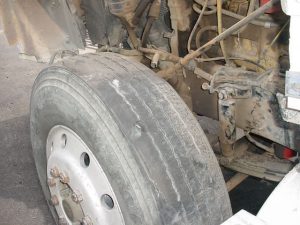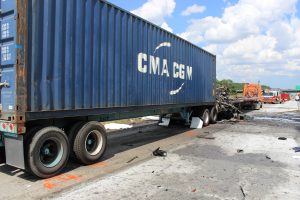While Georgia is a long way from the Mexican border, as a tractor trailer and big rig accident trial lawyer based in Atlanta, I have for several years followed the controversy over allowing Mexican trucking companies to operate in the United States. Concerns about safety rules and practices in Mexican trucking have simmered since 1995.
Today the U.S. and Mexico signed an agreement to allow Mexican tractor trailers and big rigs to operate in the U.S. and suspend retaliatory Mexican tariffs that added 5 to 25 percent to the cost of U.S. exports sold in Mexico.
This is the latest development in the long-running controversy to concerns about the safety standards of Mexican trucking, which long blocked North American Free Trade Agreement (NAFTA) rules permitting Mexican trucks to cross beyond a 25- mile border zone.
The USDOT justifies today’s action by saying that Mexican trucks must comply with all Federal Motor Vehicle Safety Standards, and will have electronic monitoring systems to track hours on the road, and that Mexican tractor trailer truck drivers must take drug tests that are analyzed in the U.S., hand over complete driving records and prove their English-language skills.
A previous cross-border pilot program for trucking certification program in 2009 included only 157 Mexican trucks.
Reactions from interest groups has varied widely:
• The US Chamber of Commerce supports the agreement as “a vital step toward a more efficient U.S.-Mexico border,” according to a statement from COC president Thomas Donohue. Truckers drop trailers at the border before crossing. Older rigs, often called transfers, pick them up to cross and leave them for a long-haul truck waiting on the other side.
• Regarding safety concerns, the Conservative Daily News blog points out that while USDOT will pay for electronic on-board recorder (EOBR) to monitor hours of service of Mexican tractor trailers, an “EOBR cannot determine if the driver of the commercial vehicle is working other than driving, or if this driver is asleep or awake. It will not ‘automatically’ do anything as the driver still must manually enter whether a change of duty status has occurred or not.” It quotes a report issued from the Congressional Research Service in February of 2010 which stated:
“The rationale of eliminating the truck drayage segment at the border, and of NAFTA in general, is to reduce the cost of trade between the two countries, thus raising each nation’s economic welfare. However the cost to federal taxpayers of ensuring Mexican truck safety, estimated by the U.S. DOT to be over $500 million as of March 2008, appears to be disproportionate to the amount of dollars saved thus far by U.S. importers or exporters that have been able to utilize long-haul trucking authority. . . . Any accumulated savings in trucking costs enjoyed by shippers therefore should be weighed against the public cost of funding the safety inspection regime for Mexican long-haul carriers.”
• The American Association for Justice Interstate Trucking Litigation Group, of which I am a board member, urged USDOT to bring up to date liability insurance coverage requirements, which have been unchanged since 1980, prior to implementing the cross-border program. The $750,000 minimum liability coverage for interstate motor carriers adopted in 1980 would be nearly $2,000,000 today if simply adjusted for inflation. USDOT responded:
“Mexico-domiciled motor carriers must establish financial responsibility, as required by 49 CFR part 387, through an insurance carrier licensed in a State in the United States. Based on the terms provided in the required endorsement, FMCSA Form MCS-90, if there is a final judgment against the motor carrier for loss and damages associated with a crash in the United States, the insurer must pay the claim. The financial responsibility claims would involve legal proceedings in the United States and an insurer based here. There is no reason that a Mexico-domiciled motor carrier, insured by a U.S.-based company, should be required to have a greater level of insurance coverage than a U.S.-based motor carrier. Increasing the minimum levels of financial responsibility for all motor carriers is beyond the scope of this notice and would require a rulemaking. In accordance with section 350(a)(1)(B)(iv), FMCSA must verify participating motor carriers’ proof of insurance through a U.S., State-licensed insurer. As a result, participating motor carriers may not self-insure.”
• The Owner-Operator Independent Drivers Association (OOIDA) is bitterly critical of the action, and is challenging it in court in Washington. OOIDA asserts that Mexico has failed to institute regulations and enforcement programs that are even remotely similar to those in the United States, and there would be no relevant corresponding reciprocity for U.S. truckers. According to OOIDA, “This program will jeopardize the livelihoods of tens of thousands of U.S.-based small business truckers and professional truck drivers and undermine the standard of living for the rest of the driver community.”
• Teamsters Union president Jim Hoffa also questioned legality of the program because it grants permanent operating authority to Mexican trucks after 18 months in the “pilot program” without Congressional authorization, and because DOT would use money from the Highway Trust Fund to pay for electronic on-board recorders for Mexican trucks. He said, “opening the border to dangerous trucks at a time of high unemployment and rampant drug violence is a shameful abandonment of the DOT’s duty to protect American citizens from harm and to spend American tax dollars responsibly.”
• Industry groups that export to Mexico, and are impacted by retaliatory Mexican tariffs, support the decision. They include the National Cattlemen’s Beef Association (NCBA) , California grape growers , and Washington State apple growers.
This Georgia truck wreck lawyer may run down to the mall to buy a Rosetta Stone home study course on Spanish.
Continue reading →

 Georgia Truck Accident Attorney Blog
Georgia Truck Accident Attorney Blog


